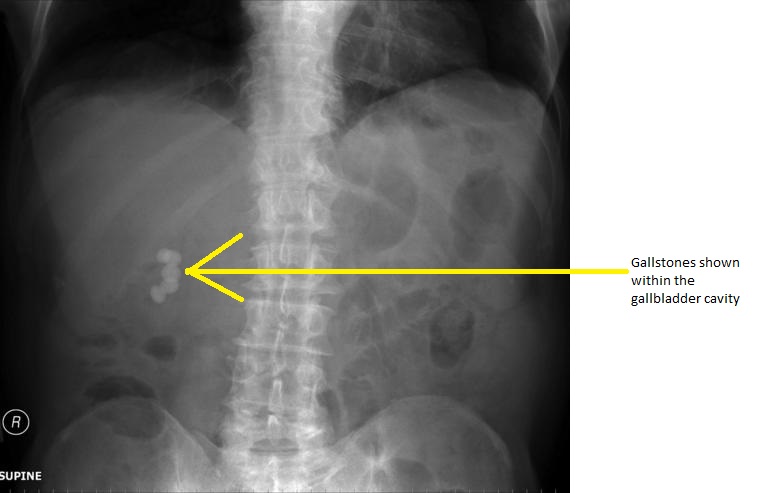Gallstone disease x ray: Difference between revisions
No edit summary |
No edit summary |
||
| Line 2: | Line 2: | ||
{{Gallstone disease}} | {{Gallstone disease}} | ||
{{CMG}}; {{AE}} | {{CMG}}; {{AE}} {{HM}} | ||
==Overview== | ==Overview== | ||
An x-ray may be helpful in the diagnosis of gallstone disease. Findings on an x-ray suggestive of gallstones include radioopaque stones within the gallbladder or biliary tree including the common bile duct and cystic duct. | |||
==X Ray== | |||
Plain abdominal X-rays rarely detect gallstones since only 10% of gallstones contain enough calcium within them to be sufficiently radioopaque and be visible on a radiograph. The majority of stones are therefore, radiolucent. CT scan sensitivity for gallstones has been estimated to be 55 to 80 percent. Gallstones may be missed on CT because many stones are isodense with bile.<ref name="pmid3797654">{{cite journal |vauthors=Barakos JA, Ralls PW, Lapin SA, Johnson MB, Radin DR, Colletti PM, Boswell WD, Halls JM |title=Cholelithiasis: evaluation with CT |journal=Radiology |volume=162 |issue=2 |pages=415–8 |year=1987 |pmid=3797654 |doi=10.1148/radiology.162.2.3797654 |url=}}</ref><ref name="pmid21862355">{{cite journal |vauthors=Benarroch-Gampel J, Boyd CA, Sheffield KM, Townsend CM, Riall TS |title=Overuse of CT in patients with complicated gallstone disease |journal=J. Am. Coll. Surg. |volume=213 |issue=4 |pages=524–30 |year=2011 |pmid=21862355 |pmc=3356270 |doi=10.1016/j.jamcollsurg.2011.07.008 |url=}}</ref> | |||
[[Image:stonexray.jpg|thumb|center|500px|Source:wikiradiography<ref name="urlGallstones - wikiRadiography">{{cite web |url=http://www.wikiradiography.net/page/Gallstones |title=Gallstones - wikiRadiography |format= |work= |accessdate=}}</ref>]] | |||
== | |||
==References== | ==References== | ||
Revision as of 18:39, 30 November 2017
|
Gallstone disease Microchapters |
|
Diagnosis |
|---|
|
Treatment |
|
Surgery |
|
Case Studies |
|
Gallstone disease x ray On the Web |
|
American Roentgen Ray Society Images of Gallstone disease x ray |
|
Risk calculators and risk factors for Gallstone disease x ray |
Editor-In-Chief: C. Michael Gibson, M.S., M.D. [1]; Associate Editor(s)-in-Chief: Hadeel Maksoud M.D.[2]
Overview
An x-ray may be helpful in the diagnosis of gallstone disease. Findings on an x-ray suggestive of gallstones include radioopaque stones within the gallbladder or biliary tree including the common bile duct and cystic duct.
X Ray
Plain abdominal X-rays rarely detect gallstones since only 10% of gallstones contain enough calcium within them to be sufficiently radioopaque and be visible on a radiograph. The majority of stones are therefore, radiolucent. CT scan sensitivity for gallstones has been estimated to be 55 to 80 percent. Gallstones may be missed on CT because many stones are isodense with bile.[1][2]

References
- ↑ Barakos JA, Ralls PW, Lapin SA, Johnson MB, Radin DR, Colletti PM, Boswell WD, Halls JM (1987). "Cholelithiasis: evaluation with CT". Radiology. 162 (2): 415–8. doi:10.1148/radiology.162.2.3797654. PMID 3797654.
- ↑ Benarroch-Gampel J, Boyd CA, Sheffield KM, Townsend CM, Riall TS (2011). "Overuse of CT in patients with complicated gallstone disease". J. Am. Coll. Surg. 213 (4): 524–30. doi:10.1016/j.jamcollsurg.2011.07.008. PMC 3356270. PMID 21862355.
- ↑ "Gallstones - wikiRadiography".